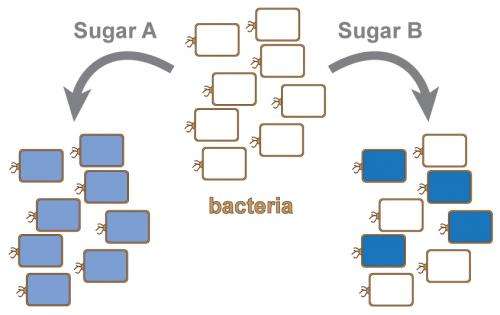When faced with some sugars, bacteria can be picky eaters

Researchers from North Carolina State University and the University of Minnesota have found for the first time that genetically identical strains of bacteria can respond very differently to the presence of sugars and other organic molecules in the environment, with some individual bacteria devouring the sugars and others ignoring it.
"This highlights the complexity of bacterial behaviors and their response to environmental conditions, and how much we still need to learn," says Dr. Chase Beisel, an assistant professor of chemical and biomolecular engineering at NC State and senior author of a paper describing the work. "This is one additional piece of the puzzle that could help us understand the behaviors of bacterial pathogens or the population dynamics of the micro-organisms that live in our guts."
The researchers grew a non-pathogenic strain of E. coli in liquid culture, with each culture rich in a different type of sugar. Bacteria produce different protein pumps and enzymes that are dedicated to taking in and breaking down specific types of sugar, but only when the relevant sugar is present.
To explore how individual bacteria respond to different sugars, the research team genetically modified the bacteria to create fluorescent proteins whenever they produced the pumps or enzymes. These fluorescent proteins acted as visual cues that the researchers could use to see how individual bacteria responded to the presence of a particular sugar.
The researchers tested the E. coli's responses to eight different sugars. For four of those sugars, all of the bacteria responded identically, increasing consumption in response to greater concentrations of sugar molecules in the culture.
But the bacteria responded differently to the other four molecules, exhibiting a wide range of behaviors.
"The behaviors were all over the place," Beisel says.
"While this is the first time we've seen such divergent behavior from bacteria regarding sugars, it's consistent with 'bet-hedging' behaviors that have been reported for bacteria in other contexts," he adds. "Bet hedging means that at least some of the bacteria will survive when faced with new environments."
The researchers also performed mathematical modeling, which found that the bacteria's diverse behaviors could be traced to the production of pumps and enzymes in the presence of sugar.
One question this study raises is whether this bet-hedging behavior is exhibited by bacteria used to convert sugars into biofuels. If it is, that would mean that a percentage of the bacteria aren't converting the sugar – which would mean the system wasn't working at peak efficiency.
"But this work raises a lot of other questions as well," Beisel says. Why does this happen in the presence of some sugars but not others? What are the circumstances in which this bet-hedging behavior actually helps the bacteria? What happens in the presence of multiple sugars? And what does this mean for bacteria in real-world conditions? For example, how would this behavior impact the introduction of probiotics – or pathogens – into the human gut?
"These are all questions we'd love to answer," Beisel says.
More information: The paper, "Bacterial sugar utilization gives rise to distinct single-cell behaviors," is published online in the journal Molecular Microbiology: onlinelibrary.wiley.com/doi/10 … 1/mmi.12695/abstract
Journal information: Molecular Microbiology
Provided by North Carolina State University




















